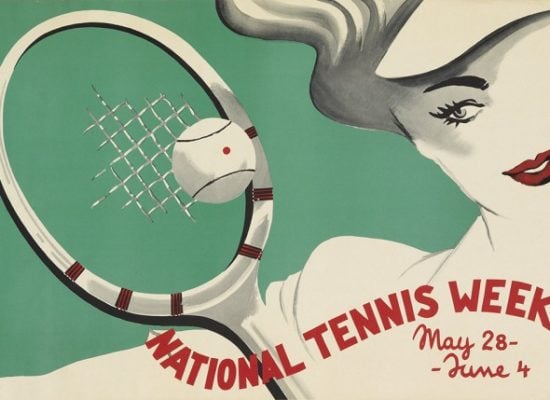Images of tennis, Buffalo Bill, and World War I and II helped push the August Vintage Posters sale at Swann Galleries to a record high. The sale, which occurred on August 6, exceeded $800,000, making it the highest grossing August posters sale at the New York auction house, sailing past its last record of $580,000 in 2012. Leading the sale was Alphonse Mucha‘s JOB (1896), which brought in $21,250 (within its estimate of $20,000–30,000).
Perhaps the most interesting segment of the sale, and the most seasonally-appropriate, was the collection of tennis posters. The private Australian collection, which spans a century and was built over the course of decades, is one of the largest known collections of such posters ever to come to auction. Among the over 80 lots in the collection (nearly one-fifth of the entire sale) were works by masters of the tennis poster like Roger Broder, Carl Moos, Edward Penfield, and Ludwig Hohlwein. The top lots were Hohlwein’s elegant Kaffee Hag (1913), which brought in $15,000 (at the low end of its its $15,000–20,000 estimate) and Broder’s Monte-Carlo (ca. 1930), one of the most popular tennis images, which sold for $16,250. (See the slideshow for a selection from the tennis poster collection.)
“Tennis posters transcend many different areas of collecting,” Swann president Nicholas D. Lowry told artnet News over the phone. “A lot of the people who showed up were tennis players, or tennis enthusiasts who realized they had a chance to buy a good image that spoke to a prominent aspect of their life.”
Asked what other collections of tennis posters were out there and known, Lowry mentioned that of tennis champ Ivan Lendl, nine of which were offered for sale in November 2007 at Poster Auctions International. That sale included A.M. Cassandre‘s Lawn Tennis (1932), which sold for $55,000, and Andrew Power’s Wimbledon (1933). Other than that sale, there were none that Lowry knew of.
“Tennis posters rarely come up for sale and almost never come up for sale in such a huge number,” Lowry continued. “When 80-plus hit the market at once, it’s pretty hard to ignore. And once you see them, it’s pretty hard to resist.”
